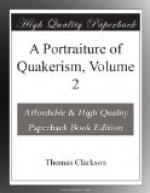When these acts of the goodness of God, with additional remarks on the passover out of Rabbi Gamaliel, have been recited, all the guests touch the dish which contains the three cakes of bread before mentioned, and say: “This sort of unleavened bread, which we eat, is because there was not sufficient time for the dough of our ancestors to rise, until the blessed Lord, the King of Kings, did reveal himself to redeem them, as it is written. And they baked unleavened cakes of the dough, which they brought forth out of Egypt; for it was not leavened, because they were thrust out of Egypt, and could not tarry; neither had they prepared for themselves any victuals.” After this they touch the horse-radish and join in a narration on the subject of their bondage. Then they take their third cup of wine, and pronounce a formula of adoration and praise, accompanied with blessings and thanksgivings, in allusion to the historical part of the passover. After this the master of the family washes his hands and says, “Blessed art thou, O Lord our God, King of the Universe, who hast sanctified us with thy Commandments, and commanded us to cleanse our hands.” He then breaks the uppermost cake of bread in the dish, and says, “Blessed art thou, O Lord our God, King of the Universe, who hast brought forth bread from the earth.” Then he takes half of another cake of bread, and breaks it, and says, “Blessed art thou, O Lord our God, King of the Universe, who hast sanctified us with thy commandments, and commanded us to eat the unleavened bread.” Then he gives every one at the table of each of the two cakes of bread that are broken, and every one repeats audibly the two last blessings. He then takes the green top from the horse-radish, and puts on the balls before mentioned, and pronounces a blessing. He then puts these into the hands of the guests, and they pronounce the same. After this, he cuts the bottom cake, and puts a piece of it upon a piece of horse-radish, and pronounces a formula of words, in allusion to an historical fact.
These ceremonies having been thus completed, the guests sup.
After supper, a long grace is said. Then the fourth cup is filled. A long prayer follows, on the subject of creation. This is again followed by a hymn, enumerating and specifying the twelve wonders which God did at midnight. Another hymn succeeds, specifying the fifteen great works which God did at different times, both on the night, and on the day, of the passover. Then follows a prayer in praise of God, in which a desire is expressed, that they may again he brought to Jerusalem. Then follows a blessing on the fourth cup which is taken; after which another hymn is sung, in which the assistance of the Almighty is invoked for the rebuilding of the temple. This hymn is followed by thirteen canticles, enumerating thirteen remarkable things belonging to the Jews, soon after which the ceremony ends.
This is the manner, or nearly the manner, in which the passover is now celebrated by the Jews. The bread is still continued to be blessed, and broken, and divided, and the cup to be blessed and handed round among the guests. And this is done, whether they live in Asia, or in Europe, or in any other part of the known world.




